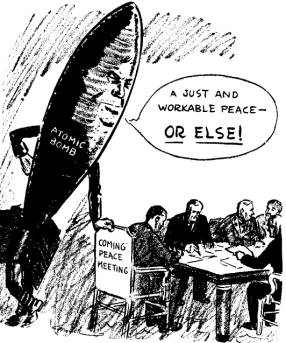|
|
|||
|
|
◄ This diagram shows the development of the Cold War, 1945-1949.
Did You Know?The author George Orwell - famous for his book 1984 - may have first coined the term "cold war" in a 1945 article in the London Tribune, written shortly after Hiroshima. Orwell envisaged a divided world where nuclear weapons had made nations unconquerable and which was in a "permanent state of 'cold war'." He predicted "an end to large-scale wars at the cost of prolonging indefinitely a 'peace that is no peace'"
|
||
|
During the Second World War, Britain and America were allies of Russia, fighting together against Germany. After the war, they became enemies. After Hiroshima, and particularly after 1949 when the Russian scientist Kurchatov gave the USSR also an atomic bomb, politicians realised that the bomb would change international politics. Another ‘hot war’ would kill all humankind. War would be MAD (mutually assured destruction). So America and Russia stopped short of war. They didn’t declare war. But they did everything to oppose each other short of war. It was called the ‘cold war’. It lasted until 1989.
|

|
◄ Source AThis cartoon of 11 August 1945 by the cartoonist Paul Carmack shows the Atomic Bomb looming threateningly over the peace-makers. The cartoon was published in the Christian Science Monitor, an American daily paper dedicated to 'nonhysterical journalism' (i.e. it tried to offer sensible and unbiased judgements on events). Click here for the interpretation
Did You Know?The original Japanese science fiction film Godzilla, made in 1954, was an allegory of the destruction caused by the dropping of the Hiroshima atomic bomb, nine years earlier.
|
|
|
| |||